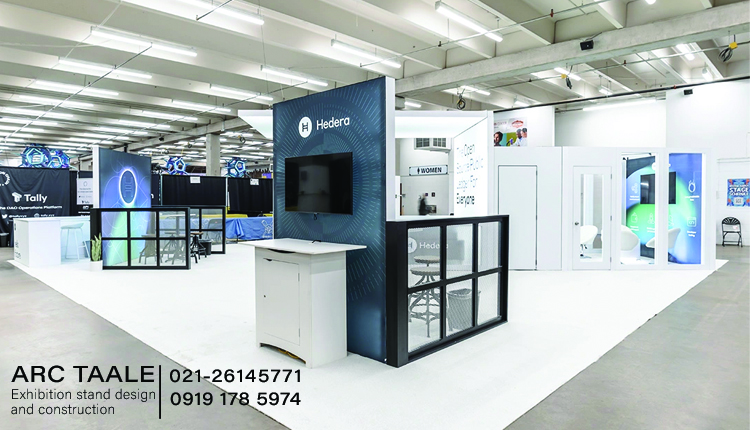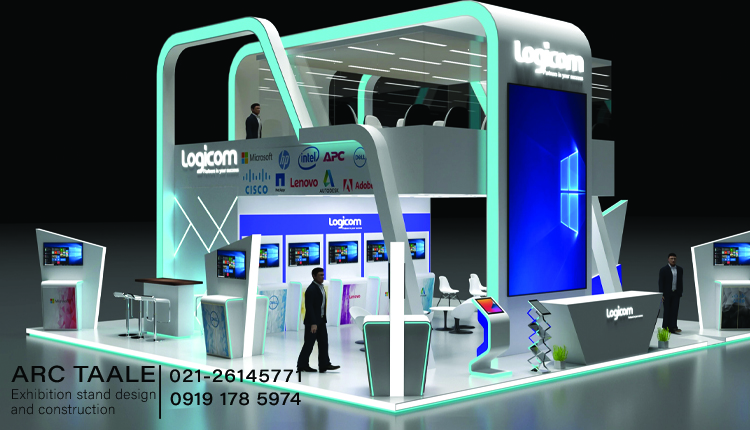Participating in the exhibition is one of the effective and cheap methods for advertising. Holding an exhibition requires a lot of planning and ceremonies. According to the type and dimensions of the exhibition, it is necessary to use various tools and equipment. It should be noted that people come to the exhibition with the intention of buying. Necessary measures must be taken to attract these people. Therefore, all the participants in the exhibition are trying to attract more people to their booth and may use various methods and tools for advertising. So, you should be smart in choosing tools and exhibition equipment.
Setting up an exhibition stand is a very difficult task that can only be achieved with careful planning and consultation with experts. If you want to have a wonderful and unique booth in the exhibition so that you can introduce your brand and products in a good way, first you need to define and identify your needs according to your goals.
What are exhibition stands made of?
Design materials and exhibition stands go hand in hand. Some materials will have specific performance capacities, and it is important to provide your booth builder with as much information as possible early in the design phase of the project. For example, let’s say you’ve finally arrived at a custom booth design that you’re happy with. However, suddenly you want to use metal instead of wood.
It won’t be as simple as changing materials, because each material has its own manufacturing methods and costs to make certain architectural components look the way you want them to. If you’re on a low budget, our exhibition stand cost guide can give you some guidance on how much things will cost. In general, it is better for you to get the more information during the design phase.
Below we give you some of important information that can guide you in building your booth:
- The budget
Low budgets give you limited stand design potential, but if you have a flexible or high budget, there’s a lot you can do. In this case, you should talk to the experts to find out your options. Be realistic about the budget and try to be as specific as possible. Sometimes, a 10-15% increase in budget is enough to take your booth’s impact to the next level.
- Durability
Some materials will last longer than others, and others may cost more to refinish or may be difficult to make look new. Consider your long-term goals and whether you want to use the same booth again and save it or build a new booth for each event.
- Regulation
There are certain regulations that apply, whether structural or venue specific. Understanding these limitations is important when designing a custom booth in different locations. For example, some designs may require permits or engineering reports.
- Aesthetics
Consider how you want your visitors to feel when they see or attend your booth and how they can help you achieve your goals.
- Brand alignment
Think about how your brand will be reflected based on the type of stands you are targeting. For example, if your company is eco-friendly, but your stand uses all kinds of plastic wrap, how does that subconsciously affect others to perceive your brand?
What is the structure of the stands?
This structure will make up most of the cost of your booth, as it is the top floor area that will be the main area for creating spaces, architectural features, product displays, storage, etc. It is legal to have regulations if your booth is against another. One wall on each side with a minimum height of 2.4m, meaning that walling will now be minimal.
· Materials
There are different materials to choose from that you can use as the main structure or as a cover to create special effects. The most used wood material is MDF.
· Wooden planks
MDF is widely used in custom exhibition stands, and due to its popularity, it becomes the most economical when purchased in bulk. Although MDF is very easy to work with .It can be made into almost any shape, it is not worth using raw MDF as a finished exposed surface, so it is often painted on a roll or covered with vinyl graphics.
· Plywood / OSB
Plywood is a tougher material that has strong structural properties. These are great as a raw finish and as a natural wood. It’s more expensive than MDF, but can be a cheaper option depending on the look you’re going for (you can leave it raw instead of painting or covering it graphically).
· Solid wood
These are great as exposed structural elements and can also be architectural features of your stand. For example, instead of making a four-sided box as a beam, you can simply use solid wood. The downside is that this material will cost more, but it creates a great natural wood finish. This is often used at coffee shows for stands that want a natural feel to their cafe style.
· Pine
Pine is another affordable material for structural use and has a nice natural wood finish. So you can use it as an exposed feature element without adding an additional finish. However, if long elements are not properly reinforced, they may tend to bend, so care should be taken with that.
· Hard wood
It is perfectly suited for high-end exposed wood veneers. This material has an excellent, professional finish, but as a result, it has a high price tag. So we don’t usually choose this option, but if you want to make a statement and premium payments are important, you can consider this item.
· Aluminum
Aluminum is a lightweight structural material and is very effective in certain cases as raw exposed architectural elements such as posts. Due to its structural properties, it is also commonly used for structural reinforcement in wood components. If the customs forms are made with aluminum, you will usually finish it by powder coating or spray painting it to match the colors of your booth brand.
· Steel
Steel is extremely strong and durable, which is why they are relatively heavy. This material is usually used for heavy construction. If left outdoors, it should be repaired, galvanized or powder coated. Applications where steel performs well are thin, heavy bases for hand sanitizer bases.
· Glass
If you are looking for a transparent surface, glass is considered the best material. However, due to its soothing properties, special precautions must be taken for shipping and handling, as it can break and crumble if not properly handled. Glass can usually be used for windows, doors and shelves.
· Acrylic
A great alternative to glass, it’s easier to work with and usually more affordable. It’s not as clear as glass, but if you’re on a tight budget, this could be a good choice for you.
· Mirror
Mirrors are great for covering surfaces, both indoors and outdoors, as their reflective properties make a space appear larger and more appealing. Similar to glass, this material must be used properly (therefore additional costs may be with using this material).
What types of structures are modular booths?
Booths are often structures that exist in the form of construction, space frame and modular, which is very important in exhibition booth construction. These structures are used for participants who present and display their goods in exhibitions.
Modular booths are stands that consist of prefabricated aluminum profile components that can be assembled. The structure of these booths is static, and in these booths, modular or interlocking systems are used to build the booths.
These types of booths are made of separate, short, regular and movable parts and are assembled. Their performances are more, compared to other prefabricated structures to create a suitable space in different dimensions and places and for different providers.
Summary
Exhibition stands are normally made of the following:
- Medium quality carpet flooring
- Booth walls with 6 mm aluminum profile structure, filling in accordance with the size of the MDF booth –
- Inscription or head of the pavilion
- Booth name
- Conventional lighting
- Power outlet
At the discretion of the exhibition organizer, one or more tables and chairs may also be installed between the booths with a light box, or a special element that has the title of the exhibition or… .



